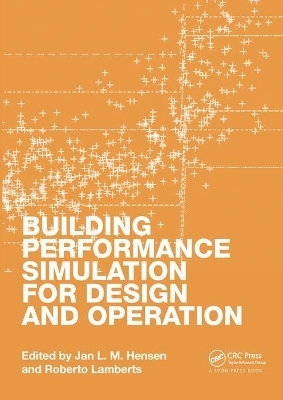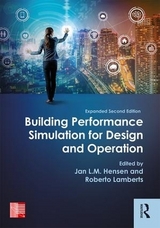
Building Performance Simulation for Design and Operation
Spon Press (Verlag)
978-0-415-47414-6 (ISBN)
- Titel erscheint in neuer Auflage
- Artikel merken
Effective building performance simulation can reduce the environmental impact of the built environment, improve indoor quality and productivity, and facilitate future innovation and technological progress in construction. It draws on many disciplines, including physics, mathematics, material science, biophysics and human behavioural, environmental and computational sciences. The discipline itself is continuously evolving and maturing, and improvements in model robustness and fidelity are constantly being made. This has sparked a new agenda focusing on the effectiveness of simulation in building life-cycle processes.
Building Performance Simulation for Design and Operation begins with an introduction to the concepts of performance indicators and targets, followed by a discussion on the role of building simulation in performance-based building design and operation. This sets the ground for in-depth discussion of performance prediction for energy demand, indoor environmental quality (including thermal, visual, indoor air quality and moisture phenomena), HVAC and renewable system performance, urban level modelling, building operational optimization and automation.
Produced in cooperation with the International Building Performance Simulation Association (IBPSA), and featuring contributions from fourteen internationally recognised experts in this field, this book provides a unique and comprehensive overview of building performance simulation for the complete building life-cycle from conception to demolition. It is primarily intended for advanced students in building services engineering, and in architectural, environmental or mechanical engineering; and will be useful for building and systems designers and operators.
Jan L. M. Hensen (Ph.D. & M.S., Eindhoven University of Technology) has his background in building physics and mechanical engineering. His professional interest is performance-based design in the interdisciplinary area of building physics, indoor environment and building systems. His teaching and research focuses on the development and application of computational building performance modelling and simulation for high performance. Roberto Lamberts is a Professor in Construction at the Department of Civil Engineering of the Federal University of Santa Catarina, Brazil. He is also currently a board member of the IBPSA, Vice-President of the Brazilian Session and Counsellor of the Brazilian Council for Sustainable Buildings.
1 Introduction to Building Performance Simulation
Jan Hensen (Eindhoven University of Technology) and Roberto Lamberts (Federal University of Santa Catarina)
2 The role of simulation in performance based building
Godfried Augenbroe (Georgia Institute of Technology, USA)
3 Weather Data for Building Performance Simulation
Dru Crawley (Bentley Systems, Inc., USA) and Chip Barnaby (Wrightsoft, USA)
4 People in building performance simulation
Ardeshir Mahdavi (Vienna University of Technology, Austria)
5 Thermal load and energy performance prediction
Jeffrey Spitler (Oklahoma State University, USA)
6 Ventilation Performance Prediction
Jelena Srebric (Pennsylvania State University, USA)
7 Indoor Thermal Quality Performance Prediction
Christoph van Treeck (Fraunhofer Institute for Building Physics, Germany)
8 Room Acoustics Performance Prediction
Ardeshir Mahdavi (Vienna University of Technology, Austria)
9 Daylight Performance Predictions
Christoph Reinhart (Harvard University, USA)
10 Moisture phenomena in whole building performance prediction
Jan Carmeliet (ETH, Zurich, Switzerland); Bert Blocken (Eindhoven University of Technology, The Netherlands), Thijs Defraeye (Katholieke Universiteit Leuven, Belgium) and Dominique Derome (EMPA, Switzerland)
11 HVAC systems performance prediction
Jonathan Wright (Loughborough University, UK)
12 Micro-cogeneration system performance predicition
Ian Beausoleil-Morrison (Carleton University, Canada)
13 Building simulation for practical operational optimization
David Claridge (Texas A&M University, USA)
14 Building simulation in building automation systems
Gregor P Henze (University of Colorado, USA) and Christian Neumann (Fraunhofer Institute, Freiburg, Germany)
15 Integrated resource flow modelling of the urban built environment
Darren Robinson (EPFL, Switzerland)
16 Building simulation for policy support
Dru Crawley (Bentley Systems, Inc., USA)
17 A view on future building system modeling and simulation
Michael Wetter (Lawrence Berkeley National Laboratory, USA)
| Erscheint lt. Verlag | 18.1.2011 |
|---|---|
| Zusatzinfo | 215 Line drawings, black and white; 50 Halftones, black and white; 64 Tables, black and white |
| Verlagsort | London |
| Sprache | englisch |
| Maße | 174 x 246 mm |
| Gewicht | 1084 g |
| Themenwelt | Technik ► Architektur |
| Technik ► Bauwesen | |
| Technik ► Maschinenbau | |
| ISBN-10 | 0-415-47414-0 / 0415474140 |
| ISBN-13 | 978-0-415-47414-6 / 9780415474146 |
| Zustand | Neuware |
| Haben Sie eine Frage zum Produkt? |
aus dem Bereich



